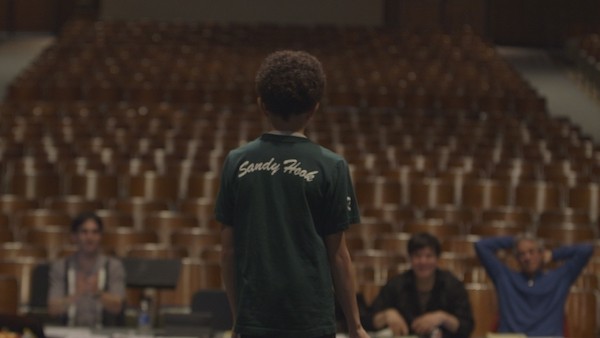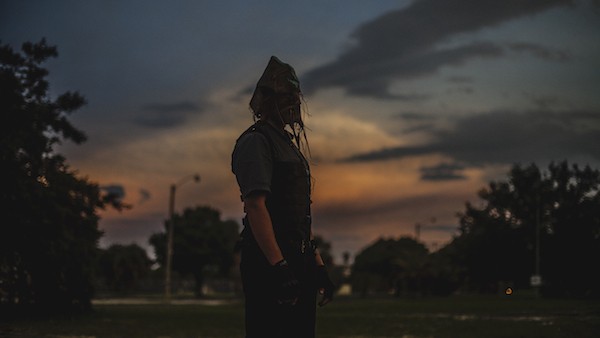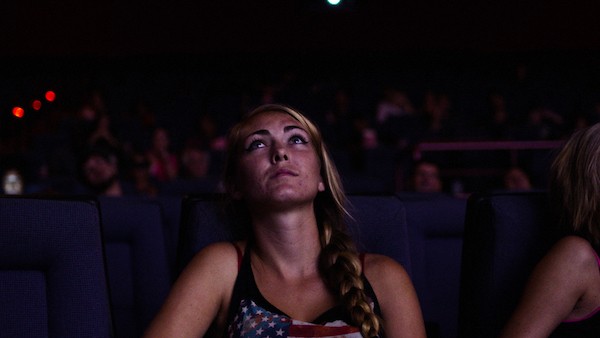The phenomenon of mass shootings has been frightening and baffling the country since the Columbine massacre in 1999. Two films at this year’s Indie Memphis film festival grapple with the issue in different ways.
On Saturday, the documentary Midsummer In Newtown looks at the psychic wreckage left in the wake of the Sandy Hook shooting. Producer Tom Yellin says the genesis of the project was a chance meeting with director Michael Unger. Yellin, a veteran of TV news turned independent documentary producer, learned that Unger, a Broadway professional, was traveling to Newtown to produce a musical adaptation of Shakespeare’s A Midsummer Night’s Dream with a cast of students from Sandy Hook. “I asked Michael if he would consider letting us capture the process, and make it the centerpiece for the film,” Yellin recalls.

Midsummer In Newtown
Yellin assembled a team and traveled to Newtown with Unger. “The hardest part of these films is getting them funded. We shot the audition process on spec. The director of our film Lloyd Kramer is a friend of mine, and he was intrigued. We went up there with a crew and shot for a couple of days, then we got a great editor and cut it together. I sent it to five people who I thought might potentially fund the film, and all five of them said they would do it. It was amazing. The email I sent just said, ‘Here’s something that’s eight minutes long.’ It didn’t have a pitch, I didn’t write anything, just ‘Take a look’.”
Eventually, Microsoft co-founder Paul Allen’s company Vulcan and Participant Media cut a deal to make the film. “It was the easiest thing I’ve ever gotten funded, and one of the hardest things I’ve ever had to do,” says Yellin.
This was not the first time Yellin had tackled the subject of mass killing. In the mid-1990s, he produced a TV special with Peter Jennings about the Oklahoma City bombing. “The Tim McVey show was a psychological profile of the making of a mass murderer. How did he become that person? We were totally focused on the perpetrator. In the case of Newtown, one of the subjects mentions the shooter, but he’s not the subject at all. It’s about what happened after the fact to the entire community, particularly the victims of this terrible tragedy. What we are really focusing on with Newtown is the resilience human beings have naturally. One way to get access to that is through art. It’s really remarkable, but ultimately not that surprising, that a play people participate in and music like a very talented musician can make, can help you get in touch with your humanity.”

Midsummer In Newtown
Midsummer In Newtown ties together the stories of the kids preparing for the production with the story of how the parents of one victim are coping with the loss of their daughter. “As we spent more and more time in Newtown, we were told that we couldn’t really understand what is happening here unless we talked to some of the families who lost their children. That was obviously a very difficult thing to do. We had Lloyd and two producers working on this, and one of them spent a lot of time in Newtown. She, family by family, made a lot of different contacts, and we settled on Jimmy and Melba. We thought the fact that Jimmy was an artist resonated deeply with the themes we were discovering as the play was going on. It took a lot of time and effort to convince them to participate, and they put some serious ground rules around their participation. You don’t see much of them, you don’t see their house. We weren’t able to interview their other child. One of the reasons they were so cautious is that they get these crazy denialists who come and yell at them, saying ‘This shooting never happened. You didn’t really have a daughter. This is a conspiracy to take away guns.’ These are crazy, crazy, sick people. They were trying to protect themselves from that, but they agreed to participate.”
Yellin says putting the two stories together in the editing room was among the biggest challenges of his professional life. “The first cut did not work. We screened it for some people, and we thought it worked, but we were told in no uncertain terms that it was not successful. I resisted, I said no, it does work. Then I watched it again, and said, ‘They’re right. It doesn’t work.’ Someone whose son or daughter may have been at Sandy Hook but survived the tragedy is just in a different category than someone who’s son or daughter did not. Putting on a play that is full of comedy is very different from living your life as a tragedy, which is what you’re resigned to when you’ve lost your child like this. Balancing these two parts out so it didn’t feel like they canceled each other out and this whole thing was a waste of time was incredibly, incredibly difficult. We really wrestled with it. Turns out the tweaking we needed was so precise and so subtle. Little things made an enormous difference. It was so hard. But I’m so proud of how it came out. I think we got it right, and audiences who have seen it say the same thing.”
Indie Memphis Weekend: Midsummer In Newtown and Dark Night Offer Different Perspectives On Mass Shootings
On Sunday, filmmaker Tim Sutton takes another tack on the problem of mass violence with Dark Night. Sutton combines fiction and documentary techniques to create a haunting day-in-the-life of a community in the hours before a mass shooting. Sutton says his film was inspired by his studies of the 2012 mass shooting in an Aurora, Colorado theater that was screening the Batman film Dark Knight and Gus Van Zandt’s 2003 film about the Columbine massacre, Elephant. “I almost called the movie Elephant. I had seen it a bunch of times, but after Aurora massacre happened, like everybody I was deeply affected by that. I was watching Elephant, and I remembered loving the pace and all that. I had a real moment where I decided that I was a going to make a movie about Aurora, and it was going to be a day in the life, and if people wanted to say it’s just like Elephant, my response would be, exactly. His movie was a way of continuing a conversation about violence from Alan Clarke’s Elephant, which is about the Troubles in Northern Ireland. I realized that no one wanted to make this movie, so I had to make this movie. It should be thought of as a direct cinematic response to Van Sandt’s Elephant, and it’s on a continuum of direct cinematic response to violence.”

Dark Night
The prevailing mood of Dark Night is suburban isolation, with characters like a fitness obsessed young woman who compulsively posts pictures of herself on Instagram. Even when they are trying to socialize, they are really alone. “It’s very rare when a character in Dark Night shares a frame with another character. These are supposed to be characters that, in any cross section of America, you’ll be able to see yourself in it, even if it’s the selfie fitness girl. The soldier home from Afghanistan or Iraq will see himself in the character who is struggling with PTSD. You’re going to see the guy down the street, who you say, why does that guy have a gun? He doesn’t need a gun. And you’re going to see the teenager you used to be, who has a journal filled with bad thoughts. You’re supposed to see these characters and identify with at least one of them, if not all of them, and replace them while you’re watching the movie with yourself.

Dark Night
Sutton thinks tackling tough, socially relevant topics is his duty as an artist. “My dream would be that a young filmmaker, in two years, makes Dark Night 2 and continues the conversation. I hope that won’t have to happen, but this kind of cinematic discussion needs to keep coming from the film community.”
Indie Memphis Weekend: Midsummer In Newtown and Dark Night Offer Different Perspectives On Mass Shootings (2)
Tickets to Midsummer In Newtown and Dark Night, as well as festival passes, are available on the Indie Memphis website.